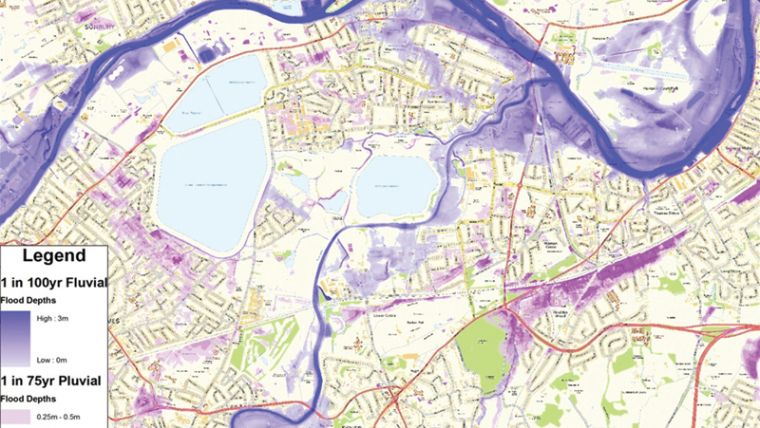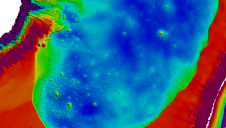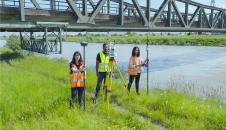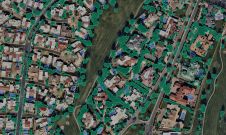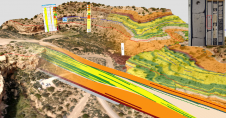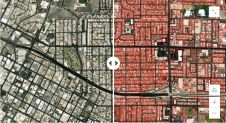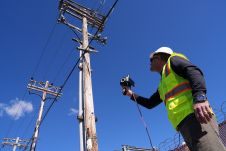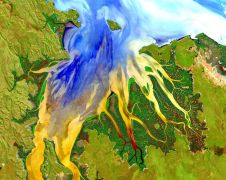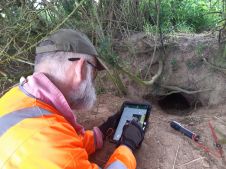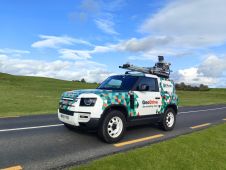Precision Flood Models and Spatial Analysis of Flood Risk
This article explains how modelling is a vital tool in understanding flood risk and in mitigating the effects of flooding in Great Britain. Paul Drury explains how recent research undertaken by flood risk specialists at Ambiental has enabled the development of precision flood models and explores how data generated through flood modelling can provide some interesting insights into the spatial pattern of flood risk.
Flood modelling depends on accurate topographic data. The resulting outputs, combined in a GIS with accurate spatial representations of our built environment, enable insurance companies, public authorities and the general public to understand flood risk and to take the precautions necessary to reduce the effects and the costs of flooding.
Flooding is a recurring phenomenon. In comparison to other environmental hazards floods in the UK generate the biggest financial losses to insurers and the wider economy. The effects of flooding have been recorded since the beginning of time and we have seen several major flooding events within recent memory. In reaction to these events, and through an appreciation of how risk may potentially increase in the future, insurance companies and other organisations are in need of tools which help them manage and better understand flood risk.
Understanding Flooding in our Past
Britain’s floods of 2007 generated insurance losses of over £3 billion – the biggest loss since records began. Thereafter we have seen significant flooding almost every year. In 2012 we experienced the wettest summer in 100 years. And more recently in 2013/14, following the wettest December and January in well over 100 years, we encountered major flooding which cost the insurance industry £1 billion and resulted in the loss of 17 lives.
Clearly, the frequent occurrence of record-breaking weather and flooding events is something we should all be concerned about, and with increasing pressure to build on flood-prone land this presents one of the biggest challenges we face as a nation. In light of this challenge, how do we go about trying to understand flooding?
Firstly we must understand that flooding can happen in a number of ways. Flood types can be divided into primary and secondary sources. Primary sources are driven by weather and natural cycles. Through the study of historical records, we are able to assign a probability of occurrence for fluvial, pluvial and tidal flooding. From this, we can predict the occurrence of frequent minor floods and of the much less frequent severe floods.
It is much more difficult to assign a probability to secondary flooding sources, which are therefore harder to predict. There is often an interlinkage between different flooding sources. For example, a sewer flood will depend on localised drainage conditions, which will exacerbate the effect of a surface water flood. Readers may also recall that the flooding in the winter of 2013/14 was made much worse through the emergence of ‘groundwater’ which caused flooding in areas supposedly protected by defences.
Historical sources such as written accounts, illustrations and flood height markers all serve as evidence from which it is possible to infer where flooding may occur in the future. However, when we attempt to make precise predictions the accuracy and completeness of historical records is an issue. To gain a fuller understanding we need detailed scientific measurements from flow gauges and depth gauges, and this type of data only exists for the last hundred years or so.
Predicting the Future
Now let us consider the probability of flooding happening. To describe the magnitude of a specific flood event we use the terminology ‘return period’. This describes the likelihood of a flood of a certain scale happening in any given year. So we can say that a 100year flood event has a 1% or a one in one hundred chance of happening this year. That is determined through a statistical analysis of historical records which consider all of the past events on record and rank them in order of magnitude.
It is important not to assume that a hundred year return period means that the same flood will occur every hundred years. In reality, it could occur much later or earlier than that. Furthermore, it is possible that a one in a hundred year event could occur next year and again the following year. However, if two flood events of one hundred year magnitude were actually to happen back to back then this will clearly change the probability of that event for the future. This is a limitation of using a deterministic approach which analyses the past to predict the future.
Flood risk in Great Britain gives rise to several headline grabbing statements. The Environment Agency state that one in six homes in England are at risk of flooding. Studies by Willis Research Network state that half a million homes are at ‘high’ risk. But what do we mean by risk, and what do we consider to be high risk? These are subjective terms. Later in this article, we will explore what we mean by risk and we will discuss how factors such as flood depth are important in establishing our view of what we define as high risk.
Flood risk is increasing in various ways. The study of natural cycles suggests that Great Britain is likely to experience a ‘flood rich’ period over the next decade or so. Furthermore, climate change may cause flood risk to increase in the future through sea level rise and more extreme rainfall events. Compounding these factors is a decrease in public spending on flood defences. With the imminent launch of the FloodRE initiative to control insurance premiums in flood prone areas, it is clear that there is a need for geodata products that enable a greater understanding of flood risk for all concerned.
Flood Modelling Techniques
GIS can be used to produce flood maps to help improve our understanding of where and when flooding will occur.
One of the main datasets used in flood modelling is topography, which has the single biggest influence on where flooding is likely to occur. A detailed digital terrain model is required to accurately show the height of the ground surface and, for flood modelling it is always best to use LiDAR data whenever possible.
Postprocessed bare earth terrain models are used which have had surface features such as vegetation and buildings removed. This allows for free movement of water and simulation of flooding within buildings. Ambiental also undertake additional terrain processing to remove flow obstructions such as bridges which otherwise will act like barriers and impede the flow of water. An understanding of the effect of structures and the relative speed with which water flows across various surfaces are also important factors in achieving predictive precision.
The other main flood model inputs all relate to hydrology. This includes flow gauges, and rainfall gauges, which are crucial to determining where water should be input to the model and how water flow should be simulated. In Great Britain, reliable flow data can be sourced from the Centre of Ecology and Hydrology. Flood hydrographs are generated from this data which represent a time sequence growth curve as flow volumes increase towards a peak flood level and then decrease as a flood subsides.
When all the data has been loaded it is time to run simulations to generate flood maps. There are a variety of flood modelling techniques available which vary in their sophistication and processing effort. Ambiental use proprietary software called FlowRoute which uses the ‘shallow water wave equation’ to simulate water movement in two dimensions. Various other simulation tools are available commercially and noncommercially.
2D flood modelling differs from 1D in that it represents differing flow conditions across a floodplain. A 2D hydrodynamic model divides the floodplain into a gridded domain where obstacles can be taken into account. Water flow between grid cells is dependent on roughness and water levels between iterative time steps.
Modelling hydraulics is the most computationally demanding stage of the process requiring high performance computers. Modelled areas are broken into small domains and the software runs each simulation in turn. The raw raster model outputs are finally merged together to form a continuous flood map for each modelled return period to simulate different flood severities.
Once simulations are complete it is necessary to evaluate whether the results are accurate. The first indicators come through the quality assurance process. Every model output is visually checked by technical analysts to identify and correct any errors in the data. Terrain models provide a top down view of the world, which means that simulated water flow under obstructions like bridges or through culverts is not enabled. Manual correction is required to remove flow impediments that cause water to dam up behind them.
Accuracy is also ensured by data validation – establishing if the flood map results correspond with the actual locations of historic flood events.
Ambiental have undertaken numerous validation studies throughout Great Britain to ensure that any known risk areas are accurately represented in their models. When there is a strong correlation between reality and the model output it serves to confirm that the modelling method is accurate and reliable.
Flood Maps for Insurance
For the insurance industry knowing where and when flooding might occur is only part of the puzzle. Flooding in the middle of nowhere, away from human settlements and infrastructure is of little consequence. Floods in an urban centre put lives, property and possessions under threat. Flood models are now detailed and accurate enough to determine flood risk at property level. So it is now possible to use GIS to produce products that deliver fresh insight to the insurance industry.
Risk is a function of hazard, vulnerability and exposure. But as we have seen so far analysing and interpreting the best available flood data does mean that the nature of the hazard can be well understood.
‘Vulnerability’ in this context describes the amount of damage occurring to structures whilst interacting with flood hazard. Some buildings will be more vulnerable as a consequence of their design and specific usage. Conversely, some buildings are much more resistant to the effects of floods, or they have been specifically designed to cope with flood hazard. The vulnerability of buildings has been studied academically and graphs can describe the ratio of damage occurring to various property types at increasing flood depths.
‘Exposure’ refers to the insurance policy, how much an asset is insured for and what policy conditions and excess have been agreed. It measures the potential losses an insurer faces in the event of the insured asset being flooded. From these three factors, we form our holistic view of risk.
Intensity will vary depending on flood return period with buildings in the red zone hit much more frequently than those in the light blue areas.
To analyse flood risk throughout Great Britain Ambiental extracted property level hazard values on a national scale. We used Ordnance Survey’s AddressBase which contains property locations, addresses and a variety of other attributes. The locations are very accurate but the data is simply a set of points which does not immediately enable detection of partial flooding. Ambiental has therefore applied a variable search buffer distance to each property type in order to extract maximum flood depth within the buffer. We found that our buffer approach brings locational uncertainty down to an acceptable level, so this approach was used to produce the FloodScore database. Ideally, the OS MasterMap building outlines would be used but they are too expensive for customers requiring an affordable flood screening tool.
This article was published in GIS Professional August 2015
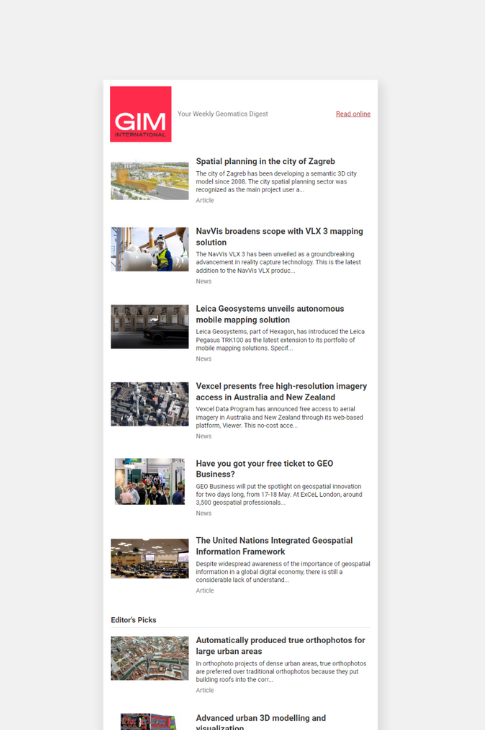
Value staying current with geomatics?
Stay on the map with our expertly curated newsletters.
We provide educational insights, industry updates, and inspiring stories to help you learn, grow, and reach your full potential in your field. Don't miss out - subscribe today and ensure you're always informed, educated, and inspired.
Choose your newsletter(s)
